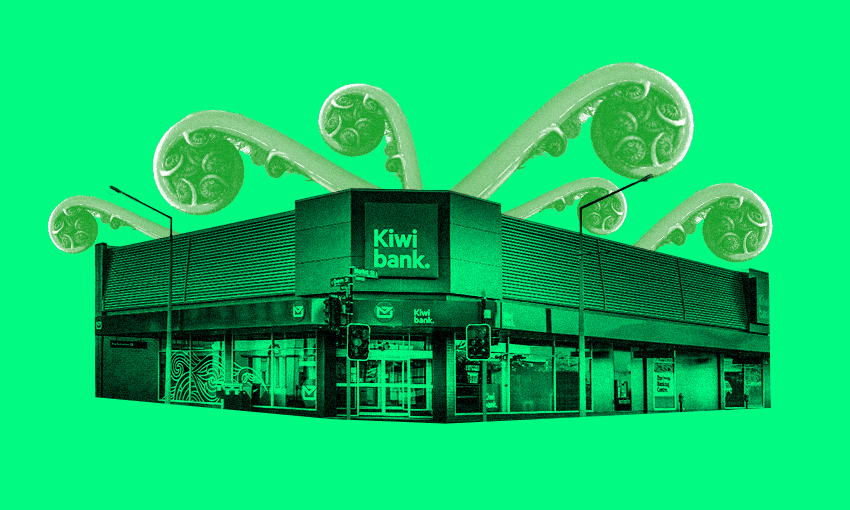In 2021, The Spinoff talked to Teaho Pihama about his work to bring tikanga Māori into Kiwibank. Two years later, we check in on the progress.
The Māori economy is already worth $70b, and it grows in value by 10% annually – a much quicker rate than the rest of New Zealand’s economy. Tangata whenua have long been innovative businesspeople who are adaptive to new sectors, technologies and products. But the Māori entrepreneurial spirit has not necessarily garnered equal and adequate support by powerful financial institutions like banks.
Te Pūtea Matua (the Reserve Bank) found that “due to a variety of reasons, the Māori economy still lags in a number of ways.” But that doesn’t need to – and shouldn’t – be the case. A thriving Māori economy is critical for tangata whenua to counter the racist disadvantages embedded within our neoliberal reality – not only for those today but for rangatahi too. Te Pūtea Matua found that the lack of access to capital – i.e. lending from banks – is a key constraint to the growth of the Māori economy. However, Kiwibank is trying to change that.
Teahooterangi (Teaho) Pihama (Te Ātiawa, Ngā Māhanga-a-Tairi, Tainui, Ngāti Maru) is the head of Māori advisory, and with Keiha Te Ngoungou (Ngāti Koroki Kahukura, Ngāti Pikiao, Ngāti Te Ngaungau) as Māori advisor they make up the Māori advisory team at Kiwibank, tasked with anchoring the strengths of te ao Māori into the largest New Zealand-owned bank, and representing the needs of Māori within the bank.
Tangata whenua tell Teaho that they don’t see themselves in Kiwibank or the banking industry at large. His mahi is to make the opposite true. Kiwibank wants to improve Māori access to banking services including lending and create a culture that draws on tikanga Māori and focuses on increasing Māori representation across the bank – explicitly in leadership and decision-making positions. It can’t do this without first engaging in introspective reflection about how Aotearoa reached this position.
Doing so awards them the social licence to operate, sound, speak and act differently so Kiwibank understands tangata whenua in a more nuanced way. Although he acknowledges they’re not where they aspire to be, Teaho mentions that Kiwibank has been successful thus far. But true success in this area is hard to quantify.
“It’s really simple now that I say it, but to engage better with te ao Māori, we really needed to increase our knowledge of te reo Maori me ona tikanga inside the workforce”, says Teaho. Te reo Māori me ona tikanga refers to uniquely tangata whenua language, customs and practices. Since 2021, Kiwibank has imparted mātauranga Māori throughout its entire workforce.
These efforts ensure Kiwibank’s employees can take te ao Māori into account and understand how their mahi impacts tangata whenua. Staff are offered te reo Māori me ona tikanga courses like Te Hoe Ākau, with rangatira receiving a particularly rigorous education. These programmes are confronting for both tangata tiriti and tangata whenua. For Māori, this education can cause intergenerational trauma to resurface. Teaho also understands that some tangata tiriti are worried about being “coined as racist” for not knowing more. To avoid both sentiments, Teaho ensures the learning programmes are safe spaces where kaimahi can ask questions or make statements without judgement. But this is just foundation-setting. Kiwibank’s mahi “all starts at the mātauranga stage”, says Teaho.
Elliot Smith, Kiwibank chief customer officer – business, says his mahi has changed in a number of ways since the business started embedding more mātauranga, tīkanga and reo Māori.
“Sharing the mātauranga in a more structured way through courses like Te Hoe Ākau [an online te reo Māori and tikanga course] means that more of our kaimahi can engage with it, build confidence and utilise it more meaningfully in everyday activities.”
Part of that mātauranga Smith thinks is crucial for Aotearoa businesses to know, is the history of the place they’re from. The opportunity to visit Ōrākei Marae and meet with some Ngāti Whātua rangatira gave Smith an important lesson in the history of the land that he calls home.
“That history has both inspirational stories and some really troubling ones, but that enriches the dialogue and makes it more important that all of Aotearoa knows these stories.”
Smith has even made some strides in his personal reo and tikanga Māori journey, learning and speaking his pepeha for the first time in a public setting outside of his work.
“[It] was a great – if challenging – experience, but the advice I give to my teams is to give it a go and over time the confidence of using te reo Māori will increase. I think there is still a fear for many that getting the pronunciation wrong is frowned on so people don’t want to look silly, but it takes practice,” he says. “I see my role in part as helping to break down some of those barriers as a leader, to help others try the language.”
Kiwibank has identified a number of factors that contribute to lower rates of access to capital (lending) for Māori. Lending secured by a residential property has a lower risk weighting from the Reserve Bank, meaning it is cheaper for the bank to lend against. Therefore low Māori home ownership rates have a direct impact on the ability of Māori-owned businesses to access bank lending. The median age of Māori is 27 and most Māori-owned businesses are still relatively young, Māori businesses generally hire more staff then non-Māori owned business, meaning they have higher costs, and the finance industry has very similar lending criteria regardless of if you are borrowing $50,000 or $500,000.
Pihama’s first job was to create awareness of this problem by educating Kiwibank management on the uncomfortable truth about Māori-Crown relations in Aotearoa. From the impacts of the Native Schools Act and Tohunga Suppression Act to the impacts of media profiling of Māori creating an accepted narrative that Māori cannot be trusted – including to repay money.
Once that was recognised, the focus shifted onto credit policies and tools available to small to medium enterprises. Kiwibank shifted the weighting towards getting to know the business and the owners capability, with reduced requirements for SME lending to be backed by residential property.
Another reason Māori have had lower levels of access to banking services is due to low representation across the industry. To combat this, Māori and Pasifika representation targets have been established to reach 18% and 15% representation within the bank’s workforce respectively. To kick this off, they are targeting leadership roles and instigating te ao Māori policies.
One of those policies is a new preference for internal hiring for vacant positions. “Internal promotion will have a disproportionately positive impact on our kaimahi Māori”, says Pihama, because while Kiwibank does have good representation of Māori and Pasifika kaimahi, they tend to be in entry level positions and are less likely to put themselves forward for promotions – instead, waiting to be shoulder tapped.
Kiwibank has also expanded their tangihanga/bereavement policy to include a wider family base and increased the number of days off given. “On a number of occasions our kaimahi Māori would seek support from Māori advisory to navigate conversations about bereavement, so we drafted a paper to the chief people officer and changed the policy,” says Pihama.
Another regular piece of feedback received was about the complexity of Māori to navigate the Kāinga Whenua loan scheme, which enables building on Māori-owned land. The Māori advisory team undertook an internal review, which saw a number of policy changes like reducing the minimum floor size from 70m2 to 50m2 and enabled whānau to use a quantity surveyor where registered valuers were unavailable. They also established a national team of Kāinga Whenua lending champions that would receive special training about the scheme, be enabled to understand more about te ao Māori and proactively engage with tangata whenua. As a result of this mahi, the ministry of housing and urban development, Kāinga Ora and Te Puni Kōkiri have undertaken a crown review into modernising the Kāinga Whenua loan scheme.
None of this would have been possible within a traditional banking industry without the right internal organisational culture. So, in 2022 Kiwibank refreshed their values to better reflect mātauranga Māori instead of outdated “jandals and stubbies Kiwiana” ideas, Teaho mentions. Following the tikanga of whanaungatanga and kotahitanga – bringing people together to build a like-minded community – 2,100 staff (over 90% of the workforce) were engaged in the refresh. The outcome was a culture “that encourages staff to do their best work through learning and growth. A culture that sets Kiwibank up to deliver performance that puts customers and partners at the heart of everything we do,” says Pihama.
It was this mahi that led to the creation of Kiwibank’s four kauwaka – the mindsets on which the organisation’s culture and knowledge is pinned – were each created to enable the bank to deliver on their purpose of Kiwi making Kiwi better off:
- Ka tīmata i a tātou – A place to belong
- Me Māia – Rise to the challenge
- Tapatahi – Better together
- Ngā Kiritaki – Customer at the heart.
“These kauwaka are anchored in the idea of them being baskets of knowledge which are designed to be shared, built on, enhanced over time and I think that’s a really important principle about how we learn as an organisation, what we celebrate and it also guides how we make decisions,” says Elliot Smith.
Pihama is also proud to see the incorporation of Māori storytelling in Kiwibank’s new brand identity. The new identity and logo were designed around the te ao Māori metaphor for a thriving whānau and community, symbolised by pā harakeke. The outer leaves are the tūpuna, representing knowledge and wisdom. The inner leaves, the mātua or parents which protect and nurture the central new shoots, which are the tamariki – the next generation and future growth. It’s a metaphor of the brand’s promise, representing where they are today and where they’re going.
Teaho hopes all this mahi will ultimately align Kiwibank more closely with the enduring, future-focused thinking of Māori. “We bring our historic mātauranga into the present to drive better outcomes for future generations”, he says, adding, “it’s about ensuring you are doing the mahi now that is going to set up mokopuna for their biggest success”.
As identified by Te Pūtea Matua, improving access to capital today is a key way for tangata whenua to get financially ahead tomorrow and beyond. But Kiwibank knows that to achieve that for generations to come, the banking industry needs to look, operate, sound, speak and act more in tune with te reo me ona tikanga. Changing the banking sector today will enable the future Māori economy to thrive, and Kiwibank – with Teaho Pihama at the helm – is leading the charge.


